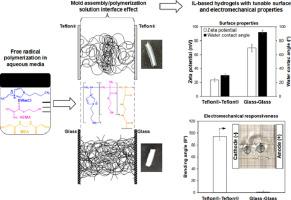Applied Materials Today ( IF 7.2 ) Pub Date : 2020-06-04 , DOI: 10.1016/j.apmt.2020.100711 A.F. Kanaan , A.P. Piedade , H.C. de Sousa , A.M.A. Dias

|
This work aims the development of electro-active polycationic soft-actuators based on copolymers of 2-hydroxyethyl methacrylate (HEMA) and 1-butyl-3-vinylimidazolium chloride (BVImCl), cross-linked with N,N’-methylene bis(acrylamide), and reinforced with mesoporous silica nanoparticles. Polycationic hydrogels were obtained by free radical polymerization in aqueous solution and using mold assemblies presenting different surface properties (e.g. Teflon® and glass). Obtained results demonstrated that a mold assembly-induced effect, at the mold/polymerization solution interface, originates “surface-to-bulk” heterogeneous copolymer concentration gradients when using Teflon®-Teflon® and Teflon®-glass mold assemblies, while homogeneous hydrogel networks were obtained when using only glass mold assemblies. Results were compared with those obtained from cross-linked poly(2-hydroxyethyl methacrylate) hydrogels to prove that the observed surface-induced polymerization effect occurs only in the presence of the ionic liquid co-monomer. Hydrogels synthesized in Teflon®-Teflon® molds presented the highest mechanical response under external electric stimulus and in different aqueous media of different pH and ionic strength. On the contrary, hydrogels synthesized in glass-glass mold assemblies presented limited mechanical actuation and only when immersed in saline aqueous media. The mechanical actuation of hydrogels synthesized in Teflon®-glass molds was shown to depend on the orientation of the applied electric current. The electro-actuation response of the synthesized electro-active polycationic hydrogels was discussed based on the ion enrichment/depletion mechanism. All prepared cationic hydrogels were also able to generate small electrical currents. Overall, these results show that mold assemblies presenting different surface properties can be employed to tune the electro-actuation responsiveness of ionic liquid-based soft actuators and lead to the development of engineering devices with a broad range of applications, including artificial muscles and tissue engineering scaffolds.
中文翻译:

模具组件诱导的界面在电响应离子液体基聚阳离子水凝胶的机械驱动中的作用
这项工作旨在开发基于甲基丙烯酸2-羟乙酯(HEMA)和1-丁基-3-乙烯基咪唑鎓氯化物(BVImCl)的共聚物的电活性聚阳离子软促动器,该共聚物与N,N'交联-亚甲基双(丙烯酰胺),并用中孔二氧化硅纳米粒子增强。聚阳离子水凝胶是通过在水溶液中进行自由基聚合并使用具有不同表面特性的模具组件(例如Teflon®和玻璃)获得的。获得的结果表明,在使用均质水凝胶网络的Teflon®-Teflon®和Teflon®-玻璃模具组件时,在模具/聚合溶液界面处,模具组件引起的效应会产生“表面到本体”的异质共聚物浓度梯度。仅使用玻璃模具组件时可获得。将结果与从交联的聚(甲基丙烯酸2-羟乙酯)水凝胶获得的结果进行比较,以证明观察到的表面诱导的聚合作用仅在离子液体共聚单体的存在下发生。在外部电刺激下以及在具有不同pH和离子强度的不同水性介质中,在Teflon®-Teflon®模具中合成的水凝胶具有最高的机械响应。相反,在玻璃-玻璃模具组件中合成的水凝胶仅在浸入盐水溶液时才表现出有限的机械驱动力。已证明在玻璃模具中合成的水凝胶的机械致动取决于所施加电流的方向。基于离子富集/耗尽机理,讨论了合成的电活性聚阳离子水凝胶的电驱动响应。所有制备的阳离子水凝胶也能够产生小电流。总体,











































 京公网安备 11010802027423号
京公网安备 11010802027423号